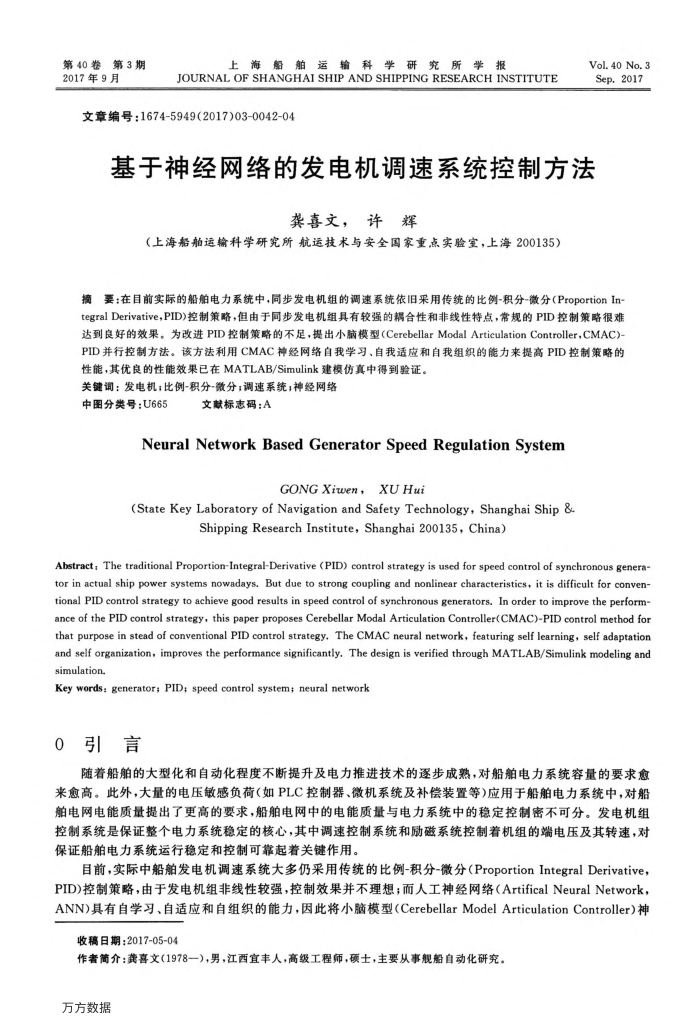您当前的位置:首页>论文资料>基于神经网络的发电机调速系统控制方法
内容简介
 第40卷第3期 2017年9月
第40卷第3期 2017年9月上海船舶运输科学研究所学报
JOURNALOF SHANGHAI SHIPANDSHIPPINGRESEARCH INSTITUTE
文章编号:1674-5949(2017)03-0042-04
Vol. 40 No. 3 Sep.2017
基于神经网络的发电机调速系统控制方法
龚喜文,许辉
(上海船舶运输科学研究所航运技术与安全国家重点实验室,上海200135)
摘要:在目前实际的船舶电力系统中,同步发电机组的调速系统依旧采用传统的比例-积分-微分(ProportionIn-tegralDerivative,PID)控制策略,但由于同步发电机组具有较强的耦合性和非线性特点,常规的PID控制策略很难达到良好的效果。为改进PID控制策略的不足,提出小脑模型(CerebellarModalArticulationController,CMAC) PID并行控制方法。该方法利用CMAC神经网络自我学习、自我适应和自我组织的能力来提高PID控制策略的
性能,其优良的性能效果已在MATLAB/Simulink建模仿真中得到验证。关键调:发电机;比例-积分-微分;调速系统;神经网络
中图分类号:U665
文献标志码:A
NeuralNetworkBasedGeneratorSpeedRegulationSystem
GONGXiwen,XUHui
(State Key Laboratory of Navigation and Safety Technology, Shanghai Ship &
Shipping Research Institute,Shanghai 200135,China)
Abstract, The traditional Proportion-Integral-Derivative (PID) control strategy is used for speed control of synchronous genera-tor in actual ship power systems nowadays., But due to strong coupling and nonlinear characteristics, it is difficult for conven-tional PID control strategy to achieve good results in speed control of synchronous generators. In order to improve the perform-ance of the PID control strategy, this paper proposes Cerebellar Modal Articulation Controller(CMAC)-PID control method for that purpose in stead of conventional PID control strategy, The CMAC neural network, featuring self learning, self adaptation and self organization, improves the performance significantly. The design is verified through MATLAB/Simulink modeling and simulation.
Key words: generator; PID; speed control system; neural network 0引言
随着船舶的大型化和自动化程度不断提升及电力推进技术的逐步成熟,对船舶电力系统容量的要求愈来愈高。此外,大量的电压敏感负荷(如PLC控制器、微机系统及补偿装置等)应用于船舶电力系统中,对船舶电网电能质量提出了更高的要求,船舶电网中的电能质量与电力系统中的稳定控制密不可分。发电机组控制系统是保证整个电力系统稳定的核心,其中调速控制系统和励磁系统控制着机组的端电压及其转速,对保证船舶电力系统运行稳定和控制可靠起着关键作用。
目前,实际中船舶发电机调速系统大多仍采用传统的比例-积分-微分(ProportionIntegralDerivative, PID)控制策略,由于发电机组非线性较强,控制效果并不理想;而人工神经网络(ArtificalNeuralNetwork, ANN)具有自学习、自适应和自组织的能力,因此将小脑模型(CerebellarModelArticulationController)神
收稿日期:2017-05-04
作者简介:黄喜文(1978一),男,江西宜丰人,高级工程师,硕士,主要从事舰船自动化研究。万方数据
上一章:基于隧道监控的火灾应急后备盘设计与应用
下一章:基于有限元法的船体吊耳数值仿真计算